

Looking ahead to 2016 and beyond........
The crop of home grown apples and pears in 2015 was pretty good, with impressive yields and good quality....prices home to the growers variable..........recently The English Apple Man highlighted the lack of sufficient financial returns to the grower as the 'driver' for more small/medium sized growers leaving the industry.
What is the prospect for the 2016 season and the future shape of our top fruit industry?
Without doubt growing is become more precise and this will continue......'precision growing' is the way forward for all horticultural crops; large scale agriculture is already dependent on precision technology; apple & pear growing is adopting new technology at an exponential rate.
How will the industry look?
While the custodians of 'heritage orchards' will hopefully preserve the less intensive systems of the past and continue to grow the old varieties known and loved by anyone with an understanding of how it 'used to be' - commercial fruit growing capable of competing with imported fruit, delivering volumes sufficient to maintain our current status as a producer of 30-40% of home grown apples on Supermarket shelves, will only survive if we embrace the most up to date technology.......
The continued move towards very intensive 'narrow hedge' systems, with trees 0.8-1.0 metre spacing in the row and at 2.5-3 metres high will increase in pace; the few very large growers with 500 - 2,000 acres of orchards are settling into this system and The English Apple Man can only foresee that being the 'view over the farm gate' - albeit with some differences in detail.
Below: left standard Bramley trees - this would have been a common scene in the period between the two World Wars - and right bush trees; the Bush tree became the system after WW2 and on into the 1960's
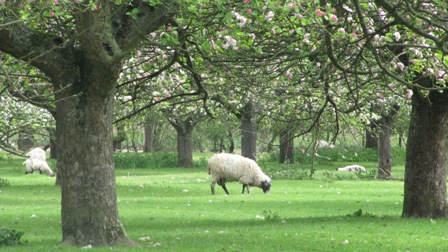
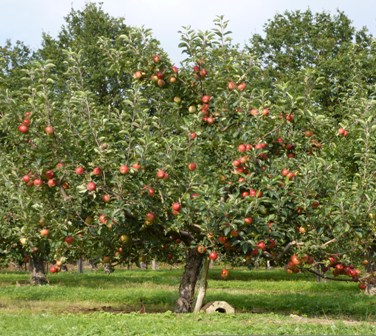
Below: this Kanzi orchard (in Lake Constance) is the 'model' for 'current tree management'
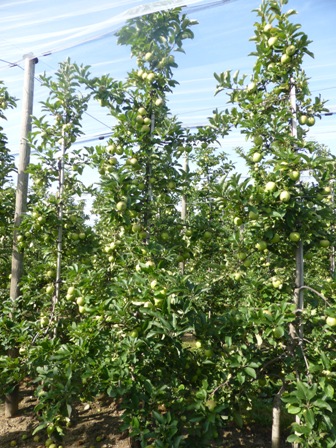 The days of standard trees are long gone and it would be difficult to find a bush tree on a commercial fruit farm, other than some kept for nostalgia's sake. The centre leader tree which became the commercial reality in the 1960's & 70's has developed from the initial 'Spindlebush tree' planted at 6 - 10 feet apart (1.85m - 3m) depending on root-stock. In those far off days of my youth, many growers still preferred the stronger MM106 root-stock planted at the wider spacing, however many progressive growers 'hung their hat' on the less vigorous M9 with a 6ft spacing. This crept in to 4ft (1.25m) as systems became more intensive.
The days of standard trees are long gone and it would be difficult to find a bush tree on a commercial fruit farm, other than some kept for nostalgia's sake. The centre leader tree which became the commercial reality in the 1960's & 70's has developed from the initial 'Spindlebush tree' planted at 6 - 10 feet apart (1.85m - 3m) depending on root-stock. In those far off days of my youth, many growers still preferred the stronger MM106 root-stock planted at the wider spacing, however many progressive growers 'hung their hat' on the less vigorous M9 with a 6ft spacing. This crept in to 4ft (1.25m) as systems became more intensive.
For a number of years many growers followed the trend created in Holland & Belgium of multi row beds. Generally 3 row beds, but sometimes 4 row beds and even the occasional (mad moment) of 7 - 8 row beds. Ironically, many UK growers 'latched onto' the bed system, just as the Benelux region dropped multi row beds and decided intensive single row systems was the 'way forward' - what we have today is a 'slender super spindle' tree close planted; often at 80 cm apart in the row.
The variations come with some growers and their advisors (probably the other way round) adopting different pruning management of the 'super spindle' - 'fruit walls' using mechanical pruning is one system which has been tried with varying degrees of success.
The modern way of thinking is no longer about trees per hectare, but surface cropping area; e.g. the tree height will dictate one dimension x 2 and the linear distance the other. For example - assuming the rows are 3.5 metres apart & 2 metres high - 285.7 x 2 x 2 = 1,142.8 sq metres of surface cropping area. Of course the depth of the row comes into play as the cubic cropping area is the production zone.... for optimum light interception the taller the tree, the narrower the 'hedgerow'....
How does The English Apple Man expect the tree system will 'settle' in the next decade?
Whatever the system, light interception is the key; the available light determines the 'design' of the most efficient system - in New Zealand the light is far superior to here in the UK and historically New Zealand and South African growers grew their trees 'far higher' than here, however even 'down under' growers are bringing tree height down while we in the UK are creeping upwards!
Below: a Zari orchard - and - a Conference orchard, both in Kent managed as a 'Super Spindle'
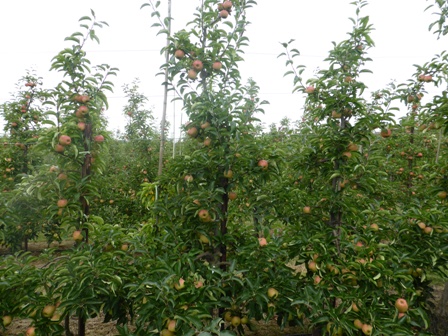
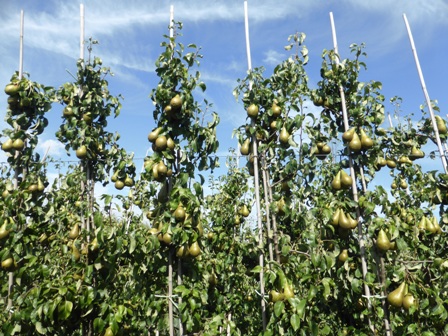
I expect much more 'detailed' tree management will shape the future tree systems; the tall super spindle will be the basis for a majority of growers; either as a single unit or as a Bibaum (twin leader tree) - while mechanical pruning into a fruit wall may become more fashionable when technology allows the mechanical pruner to mirror the capability of the 'human hand' - already mechanical pruning equipment has been developed to make cuts into the fruit wall, rather than just along the wall.
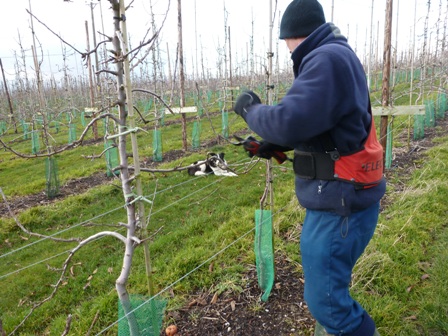
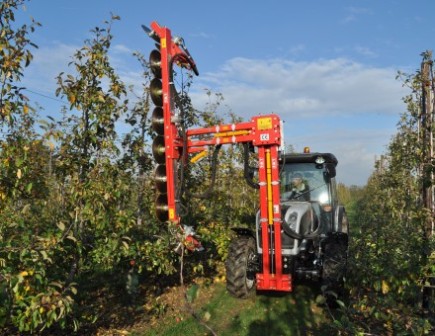
To view click on Mechanical Pruning in action
The future will revolve around narrow 'hedge row' systems with trees either grown with a single leader as a narrow profile (I call it the 'shard shape') or as a twin leader (Bibaum) system, a system which is gaining in popularity in England in recent years.
Hail protection is critical in countries/regions, where hail is prevalent and progressive growers are 'factoring in' hail protection for their new 'high density' orchards.
Below: Bibaum (twin leader trees) - left; Elstar in Lake Constance - and - right; Breaburn in Suffolk
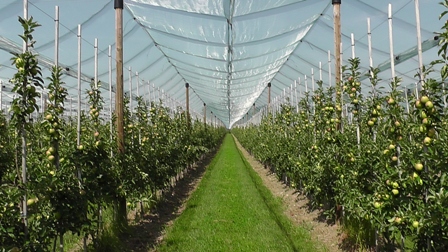
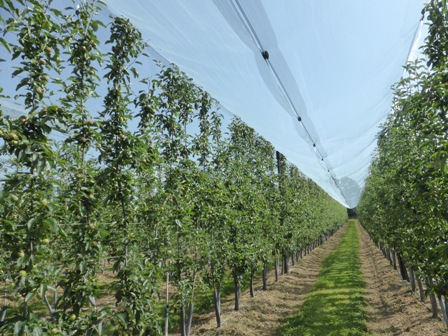
What about the apples we grow?
As consumer expectations become higher, bi-coloured apples like Gala and Braeburn need good red colour to meet the customer specification. When growers harvest it is important the first pick delivers a high proportion of good colour; anything left on the tree for a second pick will have a shorter storage life and a third pick is likely to have only juice value. That is why the trend is to plant new sports (clones) of Gala and Braeburn which have higher natural red colour is very important and the tree system which allows maximum light interception vital.
Pest & Disease control
Below: weather stations are invaluable sending data back to head office for decision making
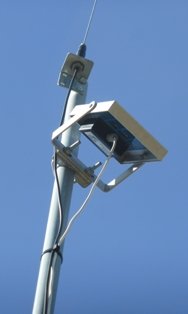 Much has been achieved by the use of predators during the last few decades, the use of predators to control Red Spider is a perfect example: Red spider used to be a serious problem requiring pesticide applications to keep it under control. Left uncontrolled the red spider mites would suck the life out of the leaves resulting in bronzed leaves. The introduction of Phytosieulus pyri changed the game completely; aligned with an understanding of which pesticides killed Phytosieulus pyri, a more empathatic spray selection has resulted in a rare need to spray for Red Spider in Conventional apple orchards. In Organic orchards, Red spider can be suppressed with regular sprays with seaweed extract and the placement of predators such as typhlodromus pyri or Amblyseius californucus.
Much has been achieved by the use of predators during the last few decades, the use of predators to control Red Spider is a perfect example: Red spider used to be a serious problem requiring pesticide applications to keep it under control. Left uncontrolled the red spider mites would suck the life out of the leaves resulting in bronzed leaves. The introduction of Phytosieulus pyri changed the game completely; aligned with an understanding of which pesticides killed Phytosieulus pyri, a more empathatic spray selection has resulted in a rare need to spray for Red Spider in Conventional apple orchards. In Organic orchards, Red spider can be suppressed with regular sprays with seaweed extract and the placement of predators such as typhlodromus pyri or Amblyseius californucus.
Research work at places like East Malling Research is continuously developing methods for managing pests and diseases in conjunction with existing sustainable methods, to create an integrated pest and pathogen management programme refined and evaluated for commercial use.
More efficient and environmentally sustainable application of pesticides
Spraying orchards with pesticides has developed over the last 100 years from a crude application of chemicals in high volumes of water per hectare, to the integrated pest management (IPM) systems used today - the application has become more refined and will continue to deliver much greater precision of necessary pesticides delivering greater efficacy and minimal invasion of the environment.
Below: an axial fan sprayer of the type used for several decades - a three row sprayer using centrifugal fans - and - a two row recycling sprayer
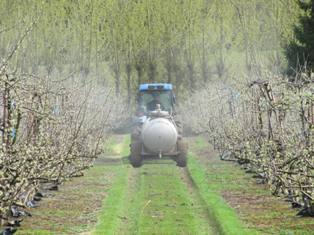
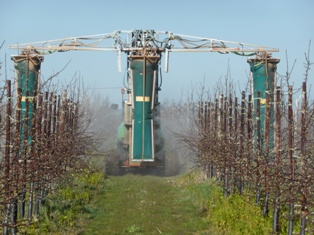
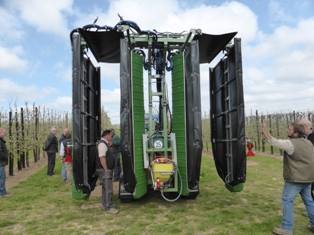
Take a look at YouTube demonstration of an Orchard Sprayer in action
Choosing the right system is important; ensuring the target is covered without spreading unnecessary pesticide beyond the target area is a matter of efficient air flow....
Below:a modern axial fan with sophisticated calibration of air flow - and - a three row version of the same sprayer
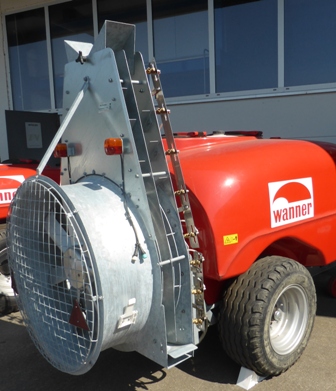
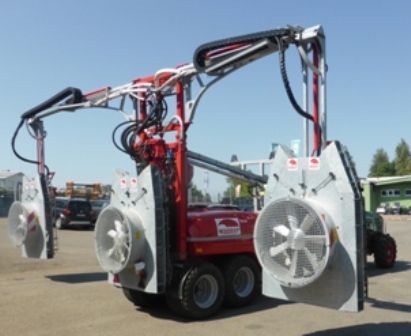
Irrigation
Irrigation has become more sophisticated in recent years; the research into delivering the optimum levels has demonstrated that trees (plants) do not benefit from over watering, flavour and texture is much improved by 'getting it right' - growers can now use systems which monitor the soil moisture and deliver exactly the right level of irrigation for the tree's needs. Savings of 60% can easily be achieved by optimising water use.
At Boxford this summer, the monitoring system not only measured soil moisture, but using an apple sensor growth can be accurately monitored. Robert England Boxford Farm Director explained that an apple will gain size during the day, but can drop back marginally at night.
Below: Boxford Farms irrigation system controls - and - apple sensor
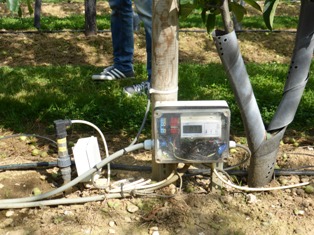
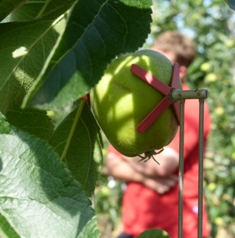
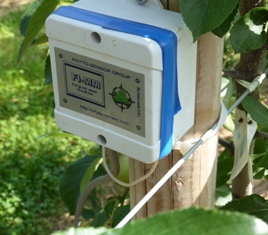
Harvesting
Harvesting on most (UK) farms utilises 'picking trains' and in some cases 'picking platforms. Apples are still, and will be for some time 'hand picked' with care. On the continent picking platforms that allow complete harvesting at all heights (a pluck a truck) are quite common, there are very few in the UK, but these picking aids will become ever more important as the introduction of the living wage escalates growers harvesting costs......
Machine picking is some years away, but will surely arrive sooner than we expect; a lot of development work is going on across the world; a machine picker for cherries and plums is operational in Poland and Thatchers Cider have developed an apple picking machine for picking their Katy apples for cider production.
Below: a picking platform in Kent - a picking platform in Italy - and a Cherry picking harvester in Poland
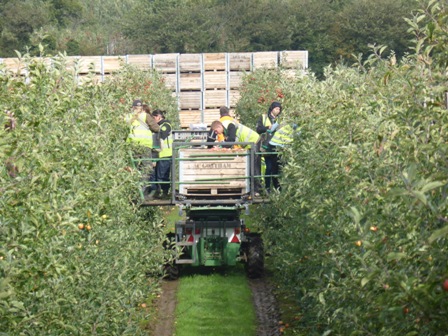
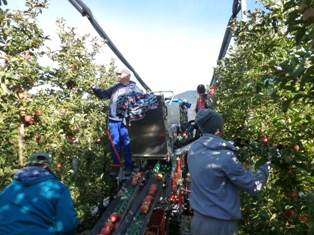
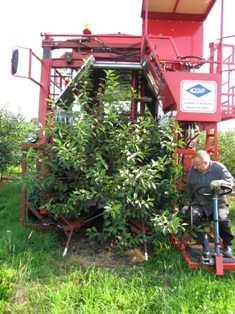
![]() The are many more advances in technology and growing systems worthy of discussion and the English Apple Man will continue to report on any advances during the months ahead......
The are many more advances in technology and growing systems worthy of discussion and the English Apple Man will continue to report on any advances during the months ahead......
Take care
The English Apple Man